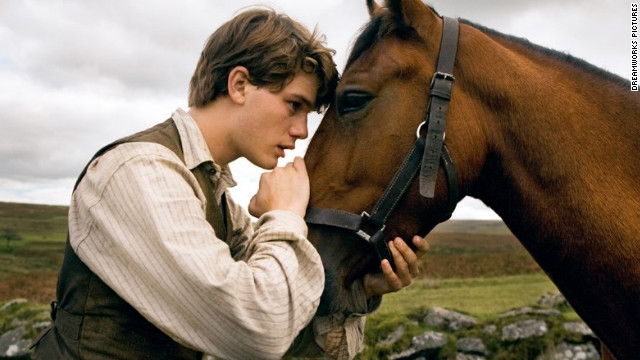'War Horse' stumbles between sentiment and horror
December 25, 2011 -- Updated 1454 GMT (2254 HKT)

Steven Spielberg's second movie of the season, "War Horse," is a very different kettle of fish from "The Adventures of Tintin."
Steven Spielberg's second movie of the season is a very different kettle of fish from "The Adventures of Tintin," which is unpretentious escapism aimed directly at the family audience.
"War Horse" is his pedigree picture, the tipsters' front-runner for the Academy Awards. But the marketing materials are also at pains to stress that this is "an epic adventure for audiences of all ages," and it's based on a children's novel by Michael Morpungo (by way of Nick Stafford's acclaimed stage adaptation), so I guess the ideal audience would be a teenage Academy voter, a history buff with a thing for horses.
Set in and immediately prior to World War I, the movie chronicles the experiences of a feisty colt, a thoroughbred who's named Joey by the tenant farmer's son (newcomer Jeremy Irvine), who cares for him and coaxes him to drag a plough through a rock pile. Sold into the army by the boy's drunken and penurious father (Peter Mullan), Joey passes from one rider to the next: a British cavalry officer (Tom Hiddleston), a German hospital orderly (David Kross), a young French girl (Celine Buckens), and so on, in the narrative equivalent of a relay race -- the horse being the baton.
Inevitably this episodic story hits highs and lows. Spielberg invests a great deal in the first act, an agrarian melodrama shot in the rosy, romantic style that David Lean brought to "Ryan's Daughter." Mullan plays one of those proud working-class types who will outbid his landlord for a pretty horse just because he likes its spirit (and has drunk too much spirits himself). The plot builds to a ploughing sequence so overwrought you would think the colt had parted the Red Sea.
John Williams' lush symphonic score is a constant presence, while Janusz Kaminski's artful lighting is another self-conscious throwback, this time to the classical style of 1940s studio filmmaking. (Almost as clearly as "The Artist," "War Horse" is Hollywood pastiche, with bits and pieces of Elia Kazan and even "Gone with the Wind" whipped into the mix.)
-
The prologue evokes a rudimentary class consciousness that evaporates as soon as Joey comes into the possession of Hiddleston's gallant cavalry captain -- whose fateful battle charge is one of the film's most impressive flourishes, and a striking expression of another of the story's obvious themes, the industrialization of warfare.
-
But the movie loses its footing badly in the next two episodes, when the focus shifts away from the horse and on to his minders: two German deserters, and then a French farmer and his granddaughter. This last is an especially ill-judged interlude, and seems only to have been included as an olive branch toward any young horse-lovers of the female persuasion who may have found themselves at this war movie by mistake.
-
The scrupulously neutral and fundamentally banal screenplay by Lee Hall ("Billy Elliot") and Richard Curtis ("Love Actually") reaches its nadir shortly afterward, when Joey apparently "volunteers" to drag heavy artillery through the mud in order to relieve a four-legged comrade he recognizes from their cavalry unit.
Such blatant Disneyfication sits very strangely alongside Spielberg's real pièce de résistance, a nightmarish, expressionist mad dash across the trenches into the barbed-wire hell of no man's land. The animal's terror and anguish is vivid and horrific, and this long sequence is reason enough to concern parents of preteens.
-
We are promised "no animals were harmed" during the filming, but there's no such guarantee for the little beasts sitting beside you. (The film is sensibly rated PG-1

No comments:
Post a Comment